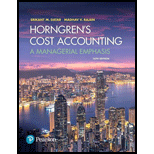
Horngren's Cost Accounting: A Managerial Emphasis (16th Edition)
16th Edition
ISBN: 9780134475585
Author: Srikant M. Datar, Madhav V. Rajan
Publisher: PEARSON
expand_more
expand_more
format_list_bulleted
Concept explainers
Textbook Question
Chapter 20, Problem 20.20MCQ
Just-in-time inventory assumes all of the following, except:
- 1. Zero defects.
- 2. Resources will only be introduced as they are needed.
- 3. Just-in-time inventory presumes first-in, first-out costing.
- 4. Production of components only occurs only when requested further downstream in the manufacturing cycle.
Expert Solution & Answer
Want to see the full answer?
Check out a sample textbook solution
Students have asked these similar questions
Financial Account subject
ACCOUNT QUESTIONS
None
Chapter 20 Solutions
Horngren's Cost Accounting: A Managerial Emphasis (16th Edition)
Ch. 20 - Why do better decisions regarding the purchasing...Ch. 20 - Name six cost categories that are important in...Ch. 20 - What assumptions are made when using the simplest...Ch. 20 - Give examples of costs included in annual carrying...Ch. 20 - Give three examples of opportunity costs that...Ch. 20 - What are the steps in computing the cost of a...Ch. 20 - Why might goal-congruence issues arise when...Ch. 20 - JIT purchasing has many benefits but also some...Ch. 20 - What are three factors causing reductions in the...Ch. 20 - You should always choose the supplier who offers...
Ch. 20 - Prob. 20.11QCh. 20 - What are the main features of JIT production, and...Ch. 20 - Distinguish inventory-costing systems using...Ch. 20 - Describe three different versions of backflush...Ch. 20 - Discuss the differences between lean accounting...Ch. 20 - The order size associated with the...Ch. 20 - Prob. 20.17MCQCh. 20 - Prob. 20.18MCQCh. 20 - Lyle Co. has only one product line. For that line,...Ch. 20 - Just-in-time inventory assumes all of the...Ch. 20 - Economic order quantity for retailer. Wonder Line...Ch. 20 - Economic order quantity, effect of parameter...Ch. 20 - EOQ for a retailer. The Fabric World sells fabrics...Ch. 20 - EOQ for manufacturer. Sk8 Company produces...Ch. 20 - Sensitivity of EOQ to changes in relevant ordering...Ch. 20 - JIT production, relevant benefits, relevant costs....Ch. 20 - Backflush costing and JIT production. Grand...Ch. 20 - Backflush costing, two trigger points, materials...Ch. 20 - Backflush costing, two trigger points, completion...Ch. 20 - Prob. 20.30PCh. 20 - Prob. 20.31PCh. 20 - Prob. 20.32PCh. 20 - Prob. 20.33PCh. 20 - JIT purchasing, relevant benefits, relevant costs....Ch. 20 - Supply-chain effects on total relevant inventory...Ch. 20 - Supply-chain effects on total relevant inventory...Ch. 20 - Backflush costing and JIT production. The Acton...Ch. 20 - Backflush, two trigger points, materials purchase...Ch. 20 - Backflush, two trigger points, completion of...Ch. 20 - Lean accounting. Reliable Security Devices (RSD)...Ch. 20 - JIT production, relevant benefits, relevant costs,...
Knowledge Booster
Learn more about
Need a deep-dive on the concept behind this application? Look no further. Learn more about this topic, accounting and related others by exploring similar questions and additional content below.Similar questions
- Degregorio Corporation makes a product that uses a material with the following direct material standards: Standard quantity 2.7 kilos per unit Standard price $9 per kilo The company produced 5,700 units in November using 15,760 kilos of the material. During the month, the company purchased 17,830 kilos of direct material at a total cost of $156,904. The direct materials purchases variance is computed when the materials are purchased. The materials quantity variance for November is: a. $3,330 F b. $3,236 F c. $3,330 U d. $3,236 Uarrow_forwardNonearrow_forwardGeneral Accountarrow_forward
- Financial accountingarrow_forwardSubject: Financial Accountingarrow_forwardThe blending department had the following data for the month of March: Units in BWIP Units completed 7,200 Units in EWIP (40% complete) 750 $27,000 Total manufacturing costs Required: 1. What is the output in equivalent units for March? 2. What is the unit manufacturing cost for March?arrow_forward
- Given answer accounting questionarrow_forwardAccounting question answerarrow_forwardIn a service concession arrangement, the operator recognizes? Correct option a) The infrastructure as its PPE b) Always a financial asset c) Always an intangible asset d) Either a financial asset or an intangible assetarrow_forward
arrow_back_ios
SEE MORE QUESTIONS
arrow_forward_ios
Recommended textbooks for you
 Managerial AccountingAccountingISBN:9781337912020Author:Carl Warren, Ph.d. Cma William B. TaylerPublisher:South-Western College Pub
Managerial AccountingAccountingISBN:9781337912020Author:Carl Warren, Ph.d. Cma William B. TaylerPublisher:South-Western College Pub

Managerial Accounting
Accounting
ISBN:9781337912020
Author:Carl Warren, Ph.d. Cma William B. Tayler
Publisher:South-Western College Pub
Chapter 6 Merchandise Inventory; Author: Vicki Stewart;https://www.youtube.com/watch?v=DnrcQLD2yKU;License: Standard YouTube License, CC-BY
Accounting for Merchandising Operations Recording Purchases of Merchandise; Author: Socrat Ghadban;https://www.youtube.com/watch?v=iQp5UoYpG20;License: Standard Youtube License